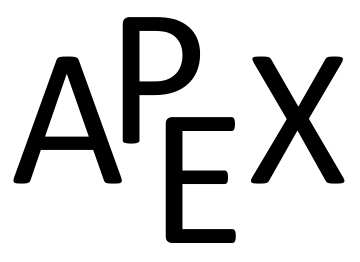To find the horizontal lines of tangency, we find where \(\frac{dy}{dx}=0\text{;}\) thus we find where the numerator of our equation for \(\frac{dy}{dx}\) is 0.
\begin{equation*}
\cos(\theta) (4\sin(\theta) +1)=0 \Rightarrow \cos(\theta) =0 \text{ or } 4\sin(\theta) +1=0\text{.}
\end{equation*}
On
\([0,2\pi]\text{,}\) \(\cos(\theta) =0\) when
\(\theta=\pi/2,\,3\pi/2\text{.}\) Setting
\(4\sin(\theta) +1=0\) gives
\(\theta=\sin^{-1}(-1/4)\approx -0.2527 = -14.48^\circ\text{.}\) We want the results in
\([0,2\pi]\text{;}\) we also recognize there are two solutions, one in the third quadrant and one in the fourth. Using reference angles, we have our two solutions as
\(\theta =3.39\) and
\(6.03\) radians. The four points we obtained where the limaçon has a horizontal tangent line are given in
Figure 9.5.4 with black-filled dots. To find the vertical lines of tangency, we set the denominator of
\(\frac{dy}{dx}=0\text{.}\)
\begin{align*}
2(\cos^2(\theta) -\sin^2(\theta) )-\sin(\theta) \amp = 0 .\\
\end{align*}
Convert the \(\cos^2(\theta)\) term to \(1-\sin^2(\theta)\text{:}\)
\begin{align*}
2(1-\sin^2(\theta) -\sin^2(\theta) )-\sin(\theta) \amp = 0\\
4\sin^2(\theta) + \sin(\theta) -2 \amp = 0.\\
\end{align*}
Recognize this as a quadratic in the variable \(\sin(\theta)\text{.}\) Using the quadratic formula, we have
\begin{align*}
\sin(\theta) \amp = \frac{-1\pm\sqrt{33}}{8}\text{.}
\end{align*}
We solve \(\sin(\theta) = \frac{-1+\sqrt{33}}8\) and \(\sin(\theta) = \frac{-1-\sqrt{33}}8\text{:}\)
\begin{align*}
\sin(\theta) \amp =\frac{-1+\sqrt{33}}8 \amp \sin(\theta) \amp = \frac{-1-\sqrt{33}}{8}\\
\theta \amp = \sin^{-1}\left(\frac{-1+\sqrt{33}}8\right) \amp \theta \amp = \sin^{-1}\left(\frac{-1-\sqrt{33}}8\right)\\
\theta \amp = 0.6349 \amp \theta \amp = -1.0030
\end{align*}
In each of the solutions above, we only get one of the possible two solutions as \(\sin^{-1}(x)\) only returns solutions in \([-\pi/2,\pi/2]\text{,}\) the \(4\)th and \(1\)st quadrants. Again using reference angles, we have:
\begin{equation*}
\sin(\theta) = \frac{-1+\sqrt{33}}8 \Rightarrow \theta = 0.6349,\,2.5067 \text{ radians }
\end{equation*}
and
\begin{equation*}
\sin(\theta) = \frac{-1-\sqrt{33}}8 \Rightarrow \theta = 4.1446,\,5.2802 \text{ radians. }
\end{equation*}
These points are also shown in
Figure 9.5.4 with white-filled dots.



